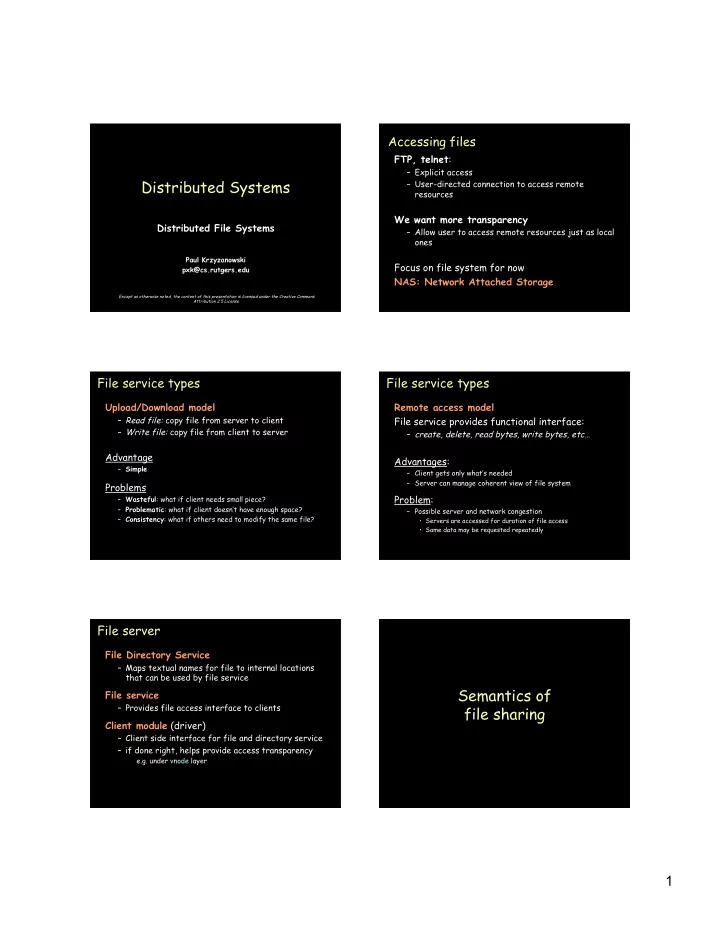

Accessing files FTP, telnet : – Explicit access Distributed Systems – User-directed connection to access remote resources We want more transparency Distributed File Systems – Allow user to access remote resources just as local ones Paul Krzyzanowski Focus on file system for now pxk@cs.rutgers.edu NAS: Network Attached Storage Except as otherwise noted, the content of this presentation is licensed under the Creative Commons Attribution 2.5 License. Page 1 Page 1 Page 2 File service types File service types Upload/Download model Remote access model – Read file: copy file from server to client File service provides functional interface: – Write file: copy file from client to server – create, delete, read bytes, write bytes, etc… Advantage Advantages: – Simple – Client gets only what’s needed – Server can manage coherent view of file system Problems Problem: – Wasteful : what if client needs small piece? – Problematic : what if client doesn’t have enough space? – Possible server and network congestion – Consistency : what if others need to modify the same file? • Servers are accessed for duration of file access • Same data may be requested repeatedly Page 3 Page 4 File server File Directory Service – Maps textual names for file to internal locations that can be used by file service Semantics of File service – Provides file access interface to clients file sharing Client module (driver) – Client side interface for file and directory service – if done right, helps provide access transparency e.g. under vnode layer Page 5 Page 6 Page 6 1
Sequential semantics Session semantics Read returns result of last write Relax the rules Easily achieved if • Changes to an open file are initially visible only to the process (or machine) that – Only one server modified it. – Clients do not cache data • Last process to modify the file wins. BUT – Performance problems if no cache • Obsolete data – We can write-through • Must notify clients holding copies • Requires extra state, generates extra traffic Page 7 Page 8 Other solutions File usage patterns Make files immutable • We can’t have the best of all worlds – Aids in replication • Where to compromise? – Does not help with detecting modification – Semantics vs. efficiency – Efficiency = client performance, network traffic, server load Or... • Understand how files are used Use atomic transactions • 1981 study by Satyanarayanan – Each file access is an atomic transaction – If multiple transactions start concurrently • Resulting modification is serial Page 9 Page 10 File usage Most files are <10 Kbytes – 2005: average size of 385,341 files on my Mac =197 KB – 2007: average size of 440,519 files on my Mac =451 KB – (files accessed within 30 days: 15, 792 files 80% of files are <47KB) – Feasible to transfer entire files (simpler) System design issues – Still have to support long files Most files have short lifetimes – Perhaps keep them local Few files are shared – Overstated problem – Session semantics will cause no problem most of the time Page 11 Page 12 Page 12 2
How do you access them? Stateful or stateless design? • Access remote files as local files Stateful • Remote FS name space should be – Server maintains client-specific state syntactically consistent with local name • Shorter requests space • Better performance in processing requests 1. redefine the way all files are named and provide a • Cache coherence is possible syntax for specifying remote files – Server can know who’s accessing what • e.g. //server/dir/file • File locking is possible • Can cause legacy applications to fail 2. use a file system mounting mechanism • Overlay portions of another FS name space over local name space • This makes the remote name space look like it’s part of the local name space Page 13 Page 14 Stateful or stateless design? Caching Stateless Hide latency to improve performance for – Server maintains no information on client accesses repeated accesses • Each request must identify file and offsets • Server can crash and recover Four places – No state to lose – Server’s disk • Client can crash and recover • No open/close needed – Server’s buffer cache WARNING: – They only establish state – Client’s buffer cache cache consistency • No server space used for state – Client’s disk problems – Don’t worry about supporting many clients • Problems if file is deleted on server • File locking not possible Page 15 Page 16 Approaches to caching Approaches to caching • Write-through • Read-ahead (prefetch) – What if another client reads its own (out-of-date) cached – Request chunks of data before it is needed. copy? – Minimize wait when it actually is needed. – All accesses will require checking with server – Or … server maintains state and sends invalidations • Write on close • Delayed writes (write-behind) – Admit that we have session semantics. – Data can be buffered locally (watch out for consistency – others won’t see updates!) – Remote files updated periodically • Centralized control – One bulk wire is more efficient than lots of little writes – Keep track of who has what open and cached on – Problem: semantics become ambiguous each node. – Stateful file system with signaling traffic. Page 17 Page 18 3
Recommend
More recommend